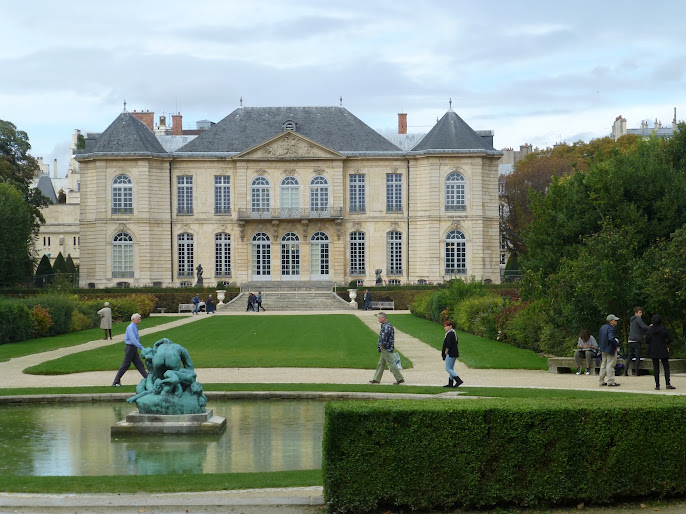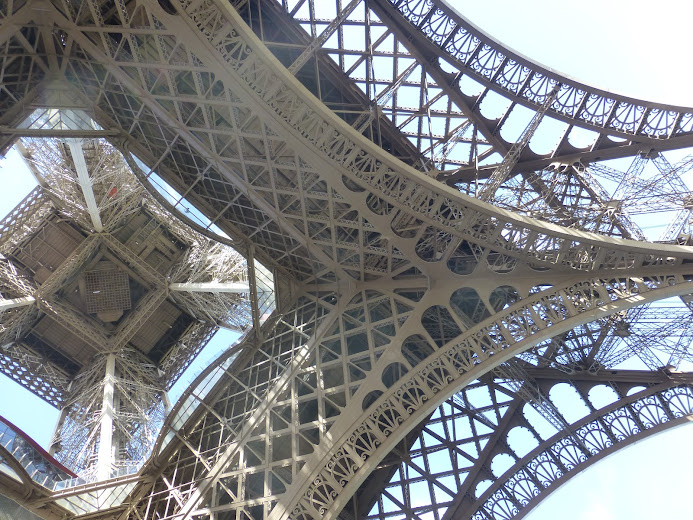The Thinker, Musee Rodin
Eiffel Tower
Eglise Protestante St-Jean
Eglise Protestante St-Jean is tucked away in a lovely hidden garden in the 7th arrondissement, not far from the Invalides. The church was built in 1910-11, and is designed in the neo-gothic style. It is a Protestant Lutheran place of worship and it can be traced to the many Alsatians of the Lutheran faith who settled in the Gros-Caillou district (a district of the 7th arrondissement) in the second half of the 19th century.
Musee Rodin in the Hotel Biron
View from Parc de Belleville
Bal du Moulin de la Galette by Renoir
The Bal du Moulin de la Galette (or Dance at the Moulin de la Galette) by Pierre-Auguste Renoir is one of my favourite paintings at the Musee d'Orsay. It perfectly captures the atmosphere of a time and a place. It was painted by Renoir in 1876 and is an impressionistic depiction of a Sunday afternoon in the Belle Epoque era, at the original Moulin de la Galette in Montmartre. In the late 19th century, this was a place where working class Parisians would dress up and go to dance, drink and eat galettes into the evening.
An artist painting at the Musee d'Orsay
The Musee d'Orsay holds the world's most comprehensive collection of impressionist masterpieces, and provides inspiration to present day artists. It usually displays about 3000 works at a time and is 15th on the list of the world's most popular museums.
École Militaire
The École Militaire sits in an impressive position at the far end of the Champs-de-Mars park (which itself was a former drilling and marching ground for the French military). The Ecole Militaire is an active military academy for training French army officers, and was founded in 1750 by King Louis XV. The site can be visited during the annual European Heritage days, which allows free access to Parisian monuments, including the Ecole Militaire that are not normally accessible to the public.
Hotel des Invalides
Musee d'Orsay

The Musee d'Orsay is located in an old railway station, the Gare d'Orsay. The station was finished in time for the 1900 Exposition Universelle. However, at the time, its design was considered to be an "anachronism", as its inspiration was taken from the past, and disguised rather than reflected what was an innovative and new form of transport.
Eiffel Tower
View towards Montmartre from the clock at Musee d'Orsay

The clock of the Orsay Museum, a former railway station, provides stunning views over Paris and its surrounds. The clock is an important symbol of both the building's history and Parisian history in general. The elegant design of the clock represents the advanced architecture of the 19th century in Paris.
Eiffel Tower
It's all a matter of perspective! A magnificent sight, and to think it was only meant to be a temporary exhibit - it was supposed to stand for 20 years only, and to be dismantled by 1909!
Musee Rodin

Eiffel Tower
View towards Pont Alexandre III bridge and Les Invalides
Musee d'Orsay
The Musee d’Orsay is a museum on the Left bank. It is housed in a former railway station, built between 1898 and 1900. The museum holds mainly French art dating from 1848 to 1914, including paintings, sculptures, furniture and photography.














